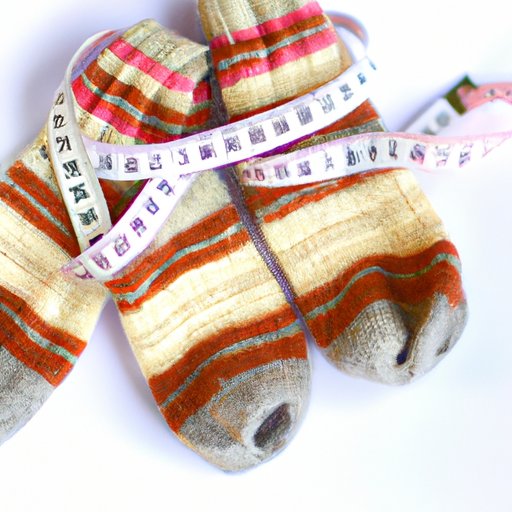
Demystifying Sock Yarn: Understanding the Weight of Your Knitting Thread
When it comes to knitting, understanding different yarn weights and classifications can be crucial. One type of yarn that often confuses knitters is sock yarn. You may have asked yourself, what weight is sock yarn? Don’t worry; you’re not alone.
In this article, we’ll explore everything you need to know about sock yarn weight. From the different weight categories to understanding gauge, we’ll provide you with a comprehensive guide that will help demystify sock yarn. Whether you’re a beginner or an experienced knitter, this article is for you.
The Ultimate Guide to Sock Yarn Weights
Before we dive into weight categories, it’s essential to understand what sock yarn is and why it’s different from other types of yarn. Sock yarn is a fine weight yarn that is durable and often made of merino wool or nylon. Its primary purpose is for knitting socks, which require a sturdy and long-lasting fabric.
Understanding yarn weight is crucial for different knitting projects. It’s essential to use the right weight yarn to achieve the desired finished product, but also to ensure the project’s success. Sock yarn weight categories are similar to other yarn weight classifications and are usually categorized as follows:
- Fingering weight
- Sport weight
- DK weight
- Worsted weight
- Bulky weight
From Fingering to Bulky: A Beginner’s Guide to Sock Yarn Weight Categories
If you’re a beginner knitter, understanding the differences between sock yarn weight categories can be overwhelming. Here’s a brief overview to get you started:
- Fingering weight: This is the lightest weight category and is often called baby weight. It’s ideal for creating delicate and intricate designs. A skein of fingering weight yarn will often contain around 400-450 yards, and the recommended needle size is 2.25mm-3.25mm.
- Sport weight: This is slightly heavier than fingering weight and is ideal for lighter garments, such as summer tops. A skein of sport weight yarn will often contain around 300-350 yards, and the recommended needle size is 3.25mm-3.75mm.
- DK weight: This weight category is ideal for creating warm and cozy garments, such as sweaters or blankets. A skein of DK weight yarn will often contain around 200-250 yards, and the recommended needle size is 3.75mm-4.5mm.
- Worsted weight: This is one of the most common weight categories used in knitting. It’s robust and ideal for creating everyday garments, such as hats or scarves. A skein of worsted weight yarn will often contain around 100-200 yards, and the recommended needle size is 4.5mm-5.5mm.
- Bulky weight: As the name suggests, bulky weight is the heaviest category and is ideal for creating thick and warm garments, such as blankets or oversized cardigans. A skein of bulky weight yarn will often contain around 90-120 yards, and the recommended needle size is 5.5mm-8mm.
Sock Yarn 101: Everything You Need to Know About Weight and Gauge
Gauge is the number of stitches and rows per inch of a fabric. It’s crucial in knitting to ensure the finished product’s size is accurate. When it comes to sock yarn, gauge is especially crucial, as socks need to fit well to be comfortable.
The needle size recommended for each weight category can impact the gauge. For example, using larger needles than recommended can result in a looser gauge and a larger finished product. Using smaller needles than recommended can result in a tighter gauge and a smaller finished product. This is important to keep in mind when choosing your sock yarn weight and gauge.
Choosing the Right Weight for Your Next Sock Yarn Project
Choosing the right weight for your sock yarn project can be challenging, but there are some key factors to consider:
- Pattern: Consider the pattern you are using for your project. The pattern may recommend a specific weight category, and using a different weight category could impact the finished product’s size and shape.
- Desired finished product: Consider the type of finished product you want. Do you want a light and delicate sock or a thick and robust sock? The weight category you choose will impact the finished product’s characteristics.
It’s also important to keep in mind that different sock yarn weights can be combined to create unique effects. For example, using a laceweight yarn for the top of a sock and a fingering weight yarn for the foot can create a beautiful and delicate design.
Exploring the Different Weight Classes of Sock Yarn and Their Uses
Each weight category of sock yarn has its unique uses. Here are some creative ideas for different weight categories:
- Fingering weight: Perfect for creating delicate lace patterns or creating lightweight and cozy socks.
- Sport weight: Ideal for creating sock designs that are a little thicker than fingering weight.
- DK weight: Perfect for creating warm and cozy socks for the colder months.
- Worsted weight: Great for creating sturdy and long-lasting everyday socks.
- Bulky weight: Ideal for creating thick and warm socks or slippers.
Conclusion
Understanding sock yarn weight is crucial for achieving a successful and comfortable sock. Remember to consider the pattern and desired finished product when choosing a weight category, and don’t be afraid to experiment with combining different weight categories to create unique effects.
Now it’s your turn! Share your sock yarn projects and experiences with us in the comments below.




